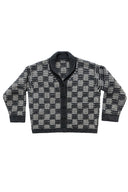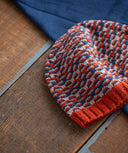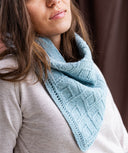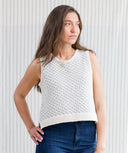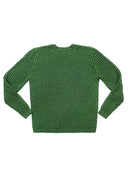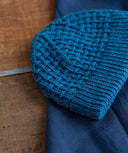Selecting a Sweater Size 101
One of the best parts about hand making garments is that they may be customized to your individual body shape and your personal style. Before selecting a pattern, we suggest spending some time discovering your preferred ease in a garment and recording your key measurements for quick reference. To aid in this process we’ve created an ease worksheet that can be used to record your key body measurements, alongside those of your favorite sweaters (store bought or handknit) to use as a reference guide in determining which sizes and styles you like to knit.
Measuring up
Start by taking out your favorite sweater, be it ready-to-wear or a handmade piece. Lay the item down flat and measure from armpit to armpit, then double that measurement for its total chest circumference. Jot down this measurement along with the waist and hip circumferences (determined by doubling the width of the sweater at these points, much like the chest circumference) from this sweater as outlined on our ease worksheet. It can be informative to note where the waist falls on the body of the sweater, if it has waist shaping.
Then, ask a friend to measure and record these same points on your body. Be sure to take your measurements while wearing a garment of similar weight to that which you’ll wear under your knits.
Easing into your project
Ease is simply the difference between your body measurements and those of the finished garment.
Positive ease allows extra room inside the garment for your body to move around — or, more plainly, the sweater circumference is larger than your body circumference. Negative ease results in a garment dimension smaller than that of the wearer, forcing the stretchy knitted fabric to expand slightly when worn. Curve-hugging sweaters and warm knit caps illustrate negative ease. When the measurements of the garment and your body are exactly the same, you have no ease in the garment.
Some designers may offer recommendations for ease, but we believe the best fit is the amount of ease you feel most comfortable in. Ease is as much about comfort as it is about styling, and everyone has slightly different preferences for how much or how little they like. Don’t be afraid to choose a different size than a pattern suggests, if the resulting garment will be more in line with the style and ease amount that you prefer in your favorite sweaters. It is also important to remember that modeled ease is not necessarily a recommendation of suggested ease but simply an example of how a garment fits on the particular person photographed wearing it! The same garment can achieve a range of looks depending on the ease with which it is worn:


Pictured above is the Box Pullover by Jared Flood in size 4 (52 ½" finished circumference at chest) on two different models. Jen (left) has a chest circumference of 42" and wears the sample with 9 ¾" of positive ease. Kristina (right) has a chest circumference of 34" and wears the same sample with 17 ¾" of positive ease.


Pictured above is the Modern Tabard by Jared Flood in size 4 (43 ¾" finished circumference at chest) on two different models. Rebekah (left) has a chest circumference of 34" and wears the sample with 9 ¾" of positive ease. Tammy (right) has a chest circumference of 42" and wears the same sample with 1 ¼" of positive ease.
Once you know how much ease you prefer, you can use that information to select a size by adding your preferred ease to your chest circumference and choosing the size whose finished circumference falls closest to the total.
An important note about fabric/yarn weight: When working with a chunky or bulky weight yarn, standard ease “rules” apply with some extra considerations. The bulkier the yarn you are using, the bigger the difference between the garment's circumference on the outside (public-facing side) and the circumference of the inside (where your body is). Because bulky yarns create very thick fabrics, the inside measurement of a bulky sweater is tighter than the outside, similar to how the lanes on the inside of a race-track are a shorter distance than the lanes on the outside.
Remember to take the thickness of your yarn/knitted fabric into account when choosing ease for sweaters that require heavier yarns.
Schematics
A schematic is the Rosetta Stone of a knitting pattern, the decoder ring that visually informs you of how the garment is constructed. From it, you can quickly glean the direction of knitting, whether the item is knit flat or in the round, the shape of the sleeves, and key dimensions for all sizes covered by the pattern. Schematics generally include both Metric and Imperial equivalents.
Compare your personal measurements against those provided in the schematic when choosing a size. If you are in-between sizes in a pattern, you’ll need to rely on the amount of ease you’d prefer in the finished garment. The chest measurement is key, used to calculate the grading in almost all hand knitting patterns. Referring back to the chest measurement of a sweater you gathered in step one, subtract your own chest measurement to yield the ease of that item.

It may be useful to circle or highlight the numbers corresponding to the size you choose to knit on the schematic before beginning your project for easy reference later.
Some thoughts on gauge
After you have selected which size to knit, ensuring you are knitting the correct gauge is the most important thing you can do to create a garment that meets your expectations.
Gauge is a measurement of the number of stitches created by your particular yarn, needles, and individual tension over a specific area. In knitting patterns, gauge is most commonly referred to as X number of stitches over four inches. The number of horizontal stitches over this specified measurement comprises the stitch gauge, while row gauge refers to the number of stitches within a vertical measurement.
What may seem to be insignificant variations in gauge will add up quickly over the circumference of a garment. In particular, row (or vertical) gauge is often overlooked. Problems with row gauge will affect the length of your finished garment as well as contribute to waist or armhole shaping that is too high or too low. Row gauge is especially critical for accurate sleeve length and yoked sweaters, in which the shaping or colorwork section is designed for a set number of rows. When possible, BT patterns include instructions for work-to lengths in order to alleviate any potential differences in row gauge and to provide the knitter the opportunity to tailor garment body and sleeve lengths to their needs.
The takeaway
Taking the time to calculate and account for ease when making a handknit garment can be time well spent, with your efforts resulting in a garment that fits the way you intend it to. We invite you to check out our ease worksheet, provided above, and hope you’ll find it useful in learning more about your personal ease and style preferences.
Ready for more? Check out Selecting A Sweater Size 201.
